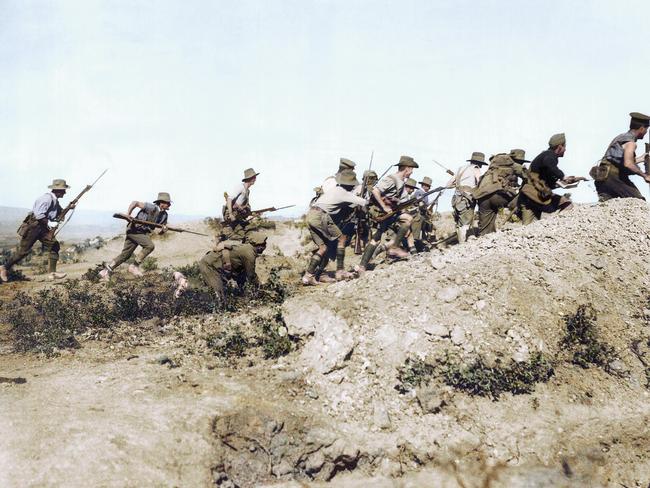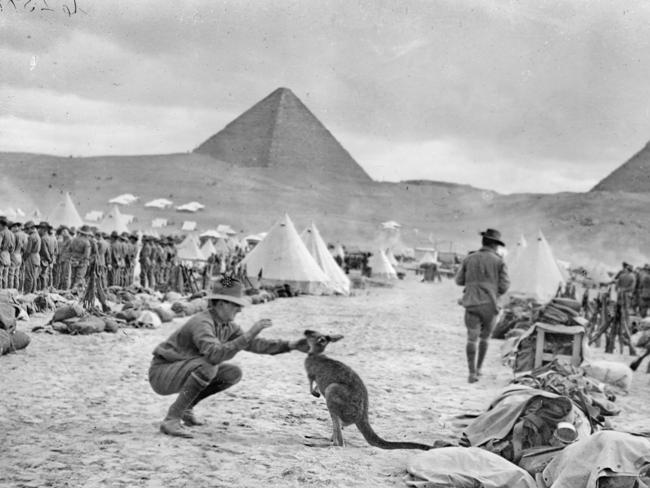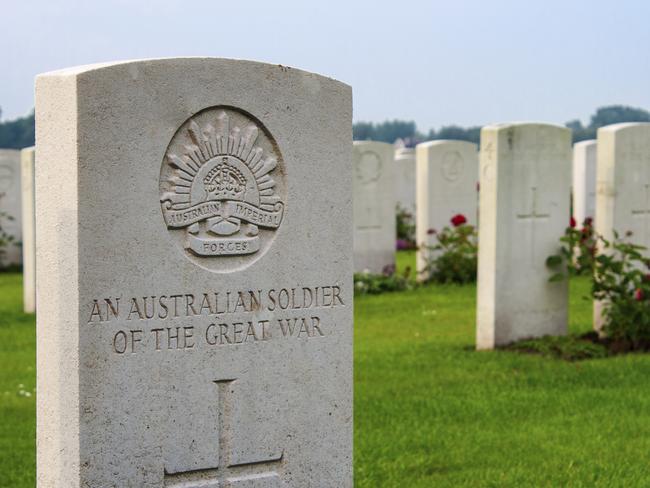Australians don’t have to wander too far from their homes to see the enduring legacy of their forebears’ sacrifices in Europe, Africa and the Middle East during the Great War of 1914-1918.
The fact we see the names of far-flung battlefields in the streets and parks of virtually every Australian city and town is testimony to how Australians have long since reconciled grief with pride while always remembering the terrible lessons of war.
Where monuments stand tall and the dead are quiet, those names were then — and are still — spoken in the hushed and grieving tones only a young and naive nation could know.
The Great War and the birth of the bronzed Anzac larrikin is so indelibly ingrained in a masculine Aussie culture that it’s difficult to determine where reality ends and legend begins
That endurance of name and commemoration probably says more about the horror, courage and sacrifices young men and women made during World War I than a dozen dusty text books.
Passchendaele, Ypres, Fromelles, The Somme, Pozieres, Villers-Bretonneux, Palestine, Egypt and, of course, Gallipoli (Anzac Cove, Lone Pine and The Nek) have become, over the past 100 years, hallowed names and places. To borrow poet Rupert Brooke’s immortal lines, they’re also “some corner of a foreign field that is forever Australia”.
Tomorrow marks exactly 100 years since the guns fell silent in Europe after more than four years of bloody conflict that claimed 17 million lives (including 7 million civilians) and brought down four empires: the Ottoman, Hapsburg, Romanov and Austro-Hungarian.
While the war didn’t officially end until the signing of the Treaty of Versailles on 28 June, 1919, the Armistice at the 11th hour of the 11th day of the 11th month has since stood as steely reminder of man’s inhumanity to man.
Australia was a young and brash colt of a nation when Britain declared war on Germany on August 4, 1914, after Germany — having pledged support to the Austro-Hungarian and the Ottoman (Turkish) Empire — invaded Luxembourg and Belgium.
Years before the Statute of Westminster granted Commonwealth nations their independence in foreign policy, Australia had little choice but to join this global war.
But, as an adoring child of the Imperial family, Australia had no qualms about testing her young mettle and, in the words of soon-to-be Labor Prime Minister Andrew Fisher, Australia would “stand beside the mother country to help and defend her to our last man and our last shilling”.
Such passions, popularised in films like Gallipoli and The Light Horseman, galvanised anti-German sentiment and mobilised an army of young Aussie men who volunteered in their thousands — over 50,000 before December 1914 — for what was popularly regarded as a marvellous, cracking adventure.


Germany was no match for the Empire, they said, and we’ll all be home by Christmas.
It’s often forgotten that more than 2000 Australian women served overseas, largely in medical services, as did more than 1000 indigenous men, with many more turned away on racial grounds. But those accepted were generally treated as equals, and paid accordingly. Tragically, too few on their return received the recognition they deserved.
It’s unfathomable today how a nation, almost as one, can eagerly send so many of its youngest and strongest to fight and die on foreign fields.
But perceptions of war in 1914 were coloured by a 19th- century romanticism that knew nothing of the 20th- century terrors of trench warfare, poison gas, heavy artillery or tanks that ploughed fields into miles of drowning mud.
It’s therefore easy to see how, after young soldiers wrote home of their horrors — or returned home on medical ships blind, limbless or insane — the zest and zeal of the next generation quickly flagged. The war was indeed a baptism by fire that forced Australia to grow up quickly.

Even so, the Great War and the birth of the bronzed Anzac larrikin is so indelibly ingrained in a masculine Aussie culture that it’s difficult to determine where reality ends and legend begins.
There are certainly myths around the role the Great War played in Australia’s development, and Associate Professor Martin Crotty, from the University of Queensland, believes it’s an oversimplification to say Australian nationalism was forged during the hellish fires of Gallipoli.
“We can’t forget [Australian Federation in] 1901, or great sporting achievements, including in cricket, or the bush legend all before the war,” Crotty says.
“But the war did have a nation–building effect. Governments grew in size as people were asked in referendums to approve conscription (Australians twice rejected Prime Minister Billy Hughes’s appeal for compulsory military service overseas to meet Britain’s demand for more troops), budgets grew enormously as pensions were paid to returning veterans, and of course men from different states all wearing the same AIF uniform created a oneness.
In that sense, the myth became the reality.”
Crotty also says it’s a myth this was Britain’s war with no place for Australia.

“Germany was an aggressor and invader,” he says. “And Australia had much at stake. Almost all Australians had British heritage, we had close trade and security links with Britain, Germany was a power in the Pacific, and if Britain went down then Australia could also have gone down,” he says.
“Australia took up the challenge, and many Australians went in with high-minded reasons.”
Regardless of those reasons, by war’s end more than 420,000 Australians — almost 20 per cent of the male population among just five million people — had joined the military, with more than 330,000 serving overseas.
Tragically, the more than 60,000 Australians killed and 137,000 wounded produced a casualty rate of almost 65 per cent — among the highest in the Empire.
The conflict also saw Australia spend £188 million — in today’s values, almost $17 billion.
But the human costs and political legacies would run so much higher.The causes of the Great War are complex and too often reduced in high school history books to the sole assassination of Austrian Archduke Franz Ferdinand in Sarajevo, in Bosnia and Herzegovina, on 24 June, 2014. But the murder of Ferdinand and his wife was merely a lit match to a long-building European powder keg.

The motive of the assassin, a young Serb named Gavrilo Princip, was to protest the Austro-Hungarian Empire’s control over Serbians in Bosnia.
But the fire the assassination ignited was itself fuelled by three principal factors: imperialism and the great European powers’ scramble for colonial spoils in Africa, the Pacific and the Middle East; the associated growth in nationalist fervour as young states, such as Germany, yearned to express a new-found identity; and a military build-up accompanying this nationalism that encouraged nation-states to flex their muscle. It’s often said the war occurred because the momentum made it too difficult to stop it.
But senior lecturer in History at Griffith University Peter Denney disagrees. “The war could have been avoided,” he says. “In the years leading up to the war people were writing of a new 20th century and a new era of lasting peace.”
But war did come and the world — not least a small and optimistic young nation such as Australia — endured real change: an expanding federal government, a reinforced nationalism, a new cultural identity of Anzac courage against impossible odds, and a new respect for war as the country grieved for a generation of men now dead or disabled.

How large would Australia’s population be today had 60,000 men not fought and died? How many hopeful Australian scientists, artists, teachers and leaders still lie under foreign soils?
Denney stresses another tragedy too often ignored.
“The Anzac legend has concealed a broader injustice,” he says. “It’s turned the war into a sacred event, when it was really a royal, aristocratic war that, today, would be very contentious.”
Among those injustices, Denny says, lies the huge number of colonial soldiers, such as Indians and Arabs, who fought and died for Britain on the shaky promise they’d be given independence after the war.
But those promises were broken and, especially in the Middle East where Britain and France divided the Ottoman Empire among themselves, the externally imposed borders imposed in Palestine and elsewhere laid the foundation for a century of tension.
But a century ago, with the wounds of war still raw, the world lamented the “War to end all wars”, formed a relatively toothless League of Nations and pledged never again to settle disputes with force.
The Great War merely fanned the flames of nationalism and — with Germans humiliated by the Treaty of Versailles and suffering under hefty reparation payments to the allies that spiked national debt and fuelled hyperinflation (in late 1923 4 trillion marks bought one US dollar) — the democratic experiment of the Weimar Republic (1919-33) hardly stood a chance.
It took only 14 years after the Armistice for an impoverished Germany to re-embrace nationalist militarism and install a heinous Nazi government. By 1939, the world was again at war.
Paul Williams is a senior lecturer at the School of Humanities, Languages and Social Science, Griffith University

Teen dead, another critical, after jet ski accident
A 15-year-old boy has died in a jet ski crash in Sydney’s south, and a 14-year-old boy has been taken to hospital in a critical condition with a severed arm.
Motorway shut after fatal truck crash
One person is dead and there are major traffic delays along the M1 Motorway after a truck crash near Morisset. Here is what we know.